A montage from the couple’s journey to Hawaii from Humboldt Bay. Photos and video of the journey provided by Jennifer Nichols and Stephen Ludwig.
Most people start their Hawaiian vacations by blasting across the sky in jumbo jets, touching down in the Aloha state after a bag of pretzels and a few bad movies. Or, they pay extra to spend several nights getting liquored up on behemoth cruise liners as big as a second-city skyscraper, gorging on midnight buffets and dancing the cha cha before pulling into port.
In defiance of these modern luxuries, Humboldt locals Stephen Ludwig and Jennifer Nichols spent nearly a month of their hard-earned vacation sailing 2,500 miles across the Pacific Ocean — Humboldt to Hanalei Bay, nonstop, alone.
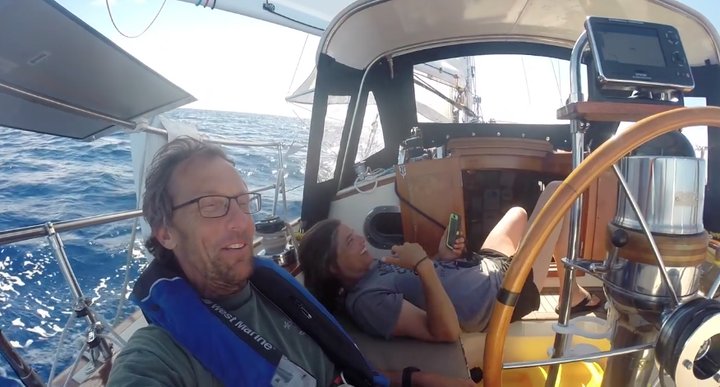
Stephen Ludwig and Jennifer Nichols on their month-long journey across the Pacific Ocean.
While the married couple has actively sailed since purchasing their first boat in 2011, the trip was by far their longest — especially for Nichols, whose farthest voyage previously consisted of a day trip to Trinidad.
“People do this all the time,” Nichols said earlier this month while sitting in the hull of their ship, the “Moonlight Mile.” “But for the average person, they don’t realize people just get in their boats and sail to Hawaii.”
The couple of 22 years purchased the “Moonlight Mile” in 2014 with the thought of one day sailing to Mexico. But as they laid on the shores of Hanalei Bay during a vacation in the summer of 2016, they had the bold idea of sailing directly to Hawaii from Humboldt County.
“We were just hanging out on the beach and I mentioned to Jenn, ‘wouldn’t that be awesome if we sailed into Hanalei Bay,’ and we started planning from there,” Ludwig said.
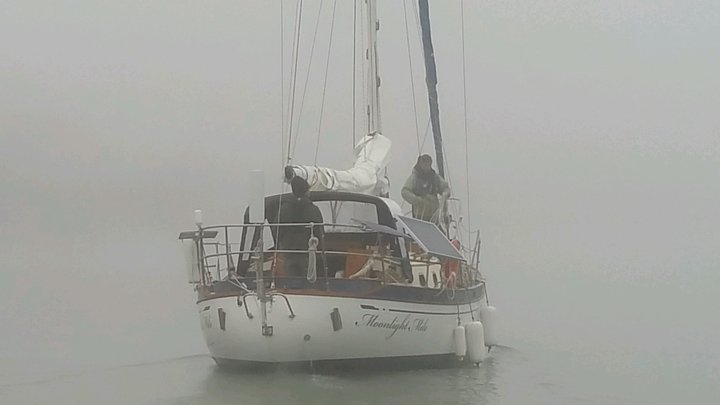
The “Moonlight Mile” in Humboldt Bay.
Sailing the world has been a lifelong dream of Ludwig’s, which he romanticized during one of the many video logs the couple recorded during their great Hawaiian adventure.
“Growing up, my brother had a globe in his room — and I would sneak into his room when he wasn’t home and spin that globe,” the St. Joe’s radiographer says in a video montage of the couple’s journey. “I would stop it with the tip of my finger, and more times than not, my finger would end up in the middle of an ocean somewhere. It always fascinated me. I understood that the world was mostly water, but I always wondered what it was like out there; the freedom that one would feel being in the middle of the ocean.”
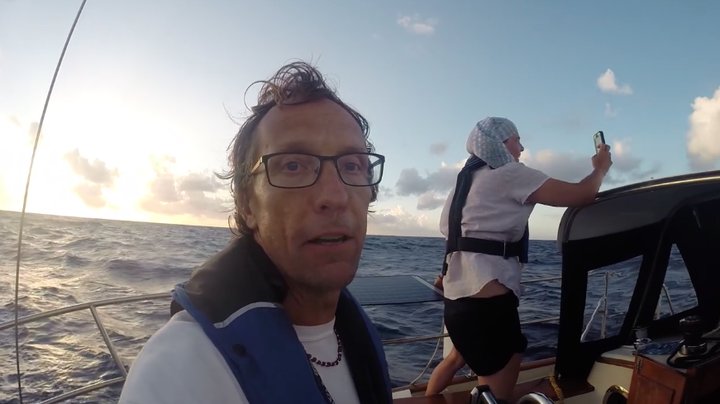
Nichols, on the other hand, never gave much thought to sailing before meeting her husband.
“I just follow him around because he’s passionate about sailing, and I’m passionate about him,” she said.
While Nichols enjoyed the difficult 23-day journey, the McKinleyville Middle School director said she isn’t interested in doing the exact same trip over again.

“I’m glad I did it. During the sail I was more like ‘this is fine’ and he was not super excited, and now that we’re done, I’m like ‘yeah whatever,’ and he’s like ‘I’m doing it again!’” Nichols said. “He enjoys the challenge. It’s hard. It’s like asking someone ‘did you have fun at your marathon?’ No. It sucks, it hurt, I was tired.”
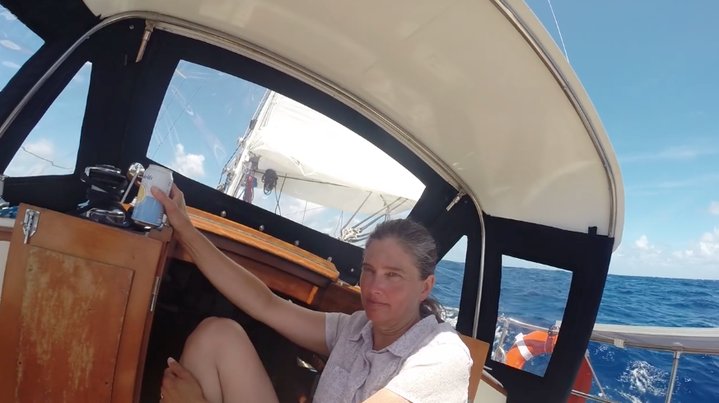
While there were beautiful moments: dolphins, flying fish, sunsets — “What I found amazing was the starry sky, the Milky Way was in it’s full glory,” Ludwig said. “The colors of the sunsets, the blue of the water. You get this really deep amazing blue water. That’s why they call it ‘blue water sailing.’” — The couple also spent several miserable, windless days bobbing around in 90-degree heat, and many sleepless nights keeping a lookout for 600-foot container ships.
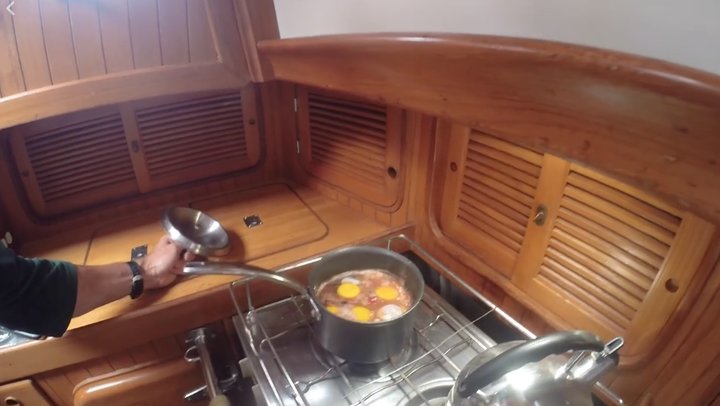
One of Ludwig’s one-pot meal recipes he perfected before the journey.
“I was thinking it would be really beautiful the whole way, and it’s kind of like a big desert, because what makes the ocean so beautiful is the view from the coastline, and the contrasts, and the animals,” Nichols said. “Once you’re out in the middle [of the ocean], there’s not a lot out there. There were a handful of birds, and there was one bird that was with us for a long time. But aside from the squid and flying fish that end up on your deck and are all toasty by the time you see them, there’s just not a lot out there.”

On the hottest days, the couple resorted to pouring buckets of ocean water over themselves and huddling around a small fan located inside the ship’s cabin to stay cool.
“We had plenty of light wind days, that’s why it took a long time,” Nichols said. “He said sailing to Hawaii is like a downhill sleigh ride, and at one point I said to Steve ‘are the trade winds a real thing? Where are they?’”
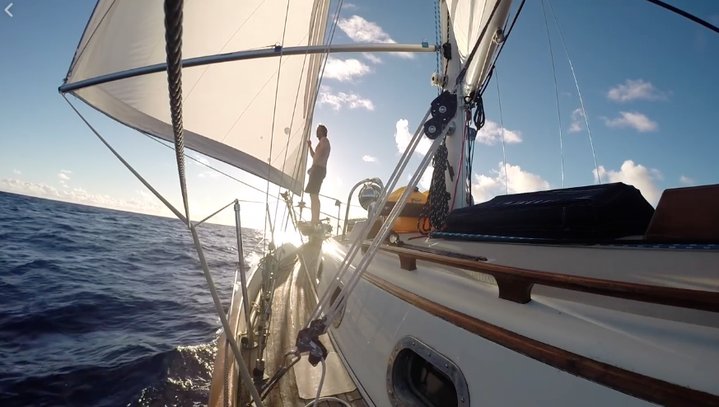
Another less desirable experience from their journey was the seemingly endless trails of trash floating around the Pacific.
“We came across a lot of trash,” Nichols said. “I saw boat debris, oil containers, plastic bottles, fishing nets, milk crates. A lot of plastic.”
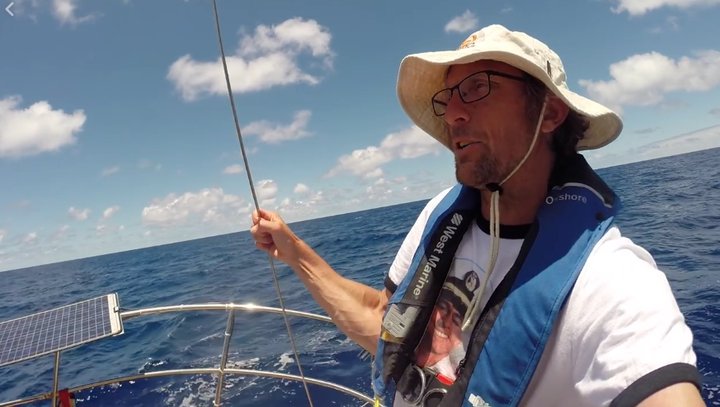
While the couple traveled there almost exclusively by wind power, there were times when they ran the ship’s engine to recharge its batteries. That’s when they noticed the plastic choking the engine’s strainer.
“That strainer was clogged with tiny bits of plastic,” Ludwig said. “[The Great Pacific Garbage Patch] isn’t this giant Texas-sized area of floating plastic you hear about. It’s there, but it’s spread out. I’m sure we sailed through it, but it was more like, ‘oh there goes something bobbing along,’ and you’d see that at the beaches in Kauai too along the tideline, little tiny bits of plastic, almost like confetti. It follows wind lines and currents, so it all bunches up into a river. You’d come across a stream of garbage and you’d be passing it for days before it would clear up. It was depressing.”

But after a few days of floating around the horse latitudes, the couple hit the trade winds and found themselves cruising toward the tropics at 7 knots.
“Once you hit the trades it’s awesome because the sails stay full, you’re moving along nicely and that’s when the boat’s happiest,” Ludwig said.
And after about 10 more days, the couple had their land-ho moment as the island of Kauai crested over the horizon.

“We sighted land around sunrise, but all you could see were clouds,” Nichols said. “Then as the day started to warm up the clouds cleared, but cloud cover stayed right in one spot and I said ‘that’s over the Hanalei river.’ That’s right where we were heading.”
And as the couple neared their cloudy waypoint, they were treated to a victory arch of a rainbow, welcoming them in from their journey.
“There was this rainbow coming straight down out of the the clouds, pointing straight to where we were going,” Nichols said. “The closer we got, the more the clouds lifted and pretty soon we were literally sailing under the rainbow. It was so close it was reflecting on the water and over the hull. It was really cool.”
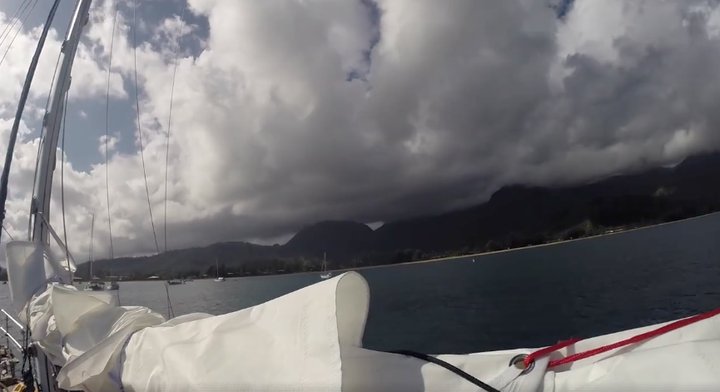
Hanalei Bay.
As they pulled into the bay, Ludwig and Nichols were greeted by their family, who arrived there days earlier. And after nearly a month of braving the sea, dodging cargo ships, roasting in the sun, Stephen Ludwig and Jennifer Nichols started their vacation.
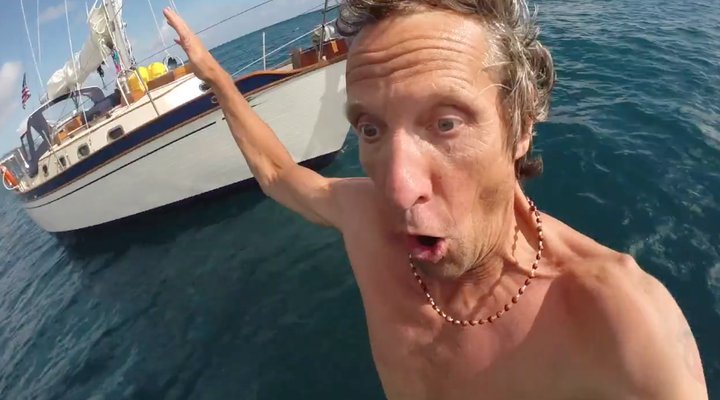
For the next 17 days, the couple soaked in paradise: surfing in Poipu, snorkeling at Tunnels Beach, eating fresh seafood and hiking the island forests.
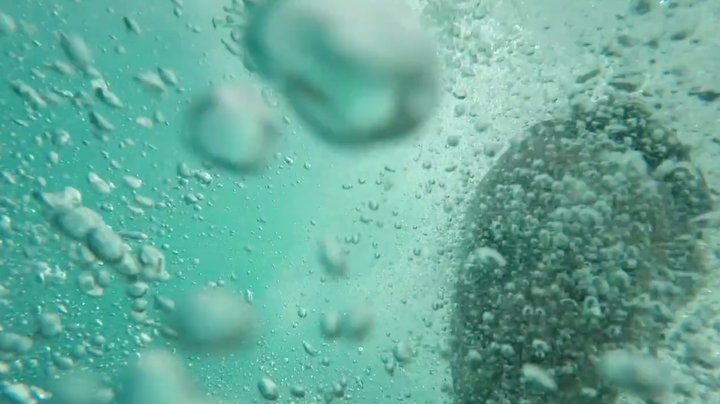
“I did not want to come back,” Ludwig said. “I can see why sailors committed mutiny after reaching the South Pacific Islands. Why would one want to leave and get back on a rat infested, dirty, crowded ship and face the dangers of the sea.”
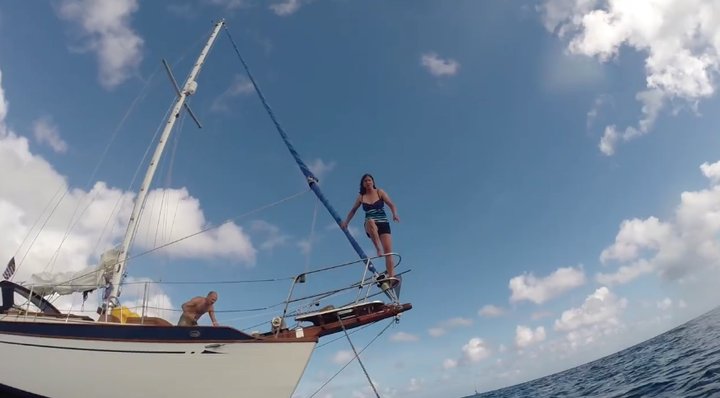
As for the ship, that was the end of their journey. After their vacation, the couple flew home and arranged for their boat to be sailed home by another crew.
“I was tired,” Ludwig said. “In hindsight, I regret not going back because I had a buddy that was willing to do it with me. But now I know what it’s capable of, what I’m capable of, and there’ll be more adventures in the future — especially in this boat.”
Overall, between supplies, fuel, parts, fancy equipment, the cost of the adventure was much more expensive than flying or taking a cruise
“It would equal out for several years of sailing to Hawaii,” Nichols said.
But the couple has big plans for this ship. To his wife’s reluctance, Ludwig plans to sail the Singlehanded Transpac race from San Francisco to Hanalei Bay next summer. And earlier this month, as they sat on the deck of the “Moonlight Mile” — now docked in Humboldt Bay — they started to hash out their next couple’s adventure.
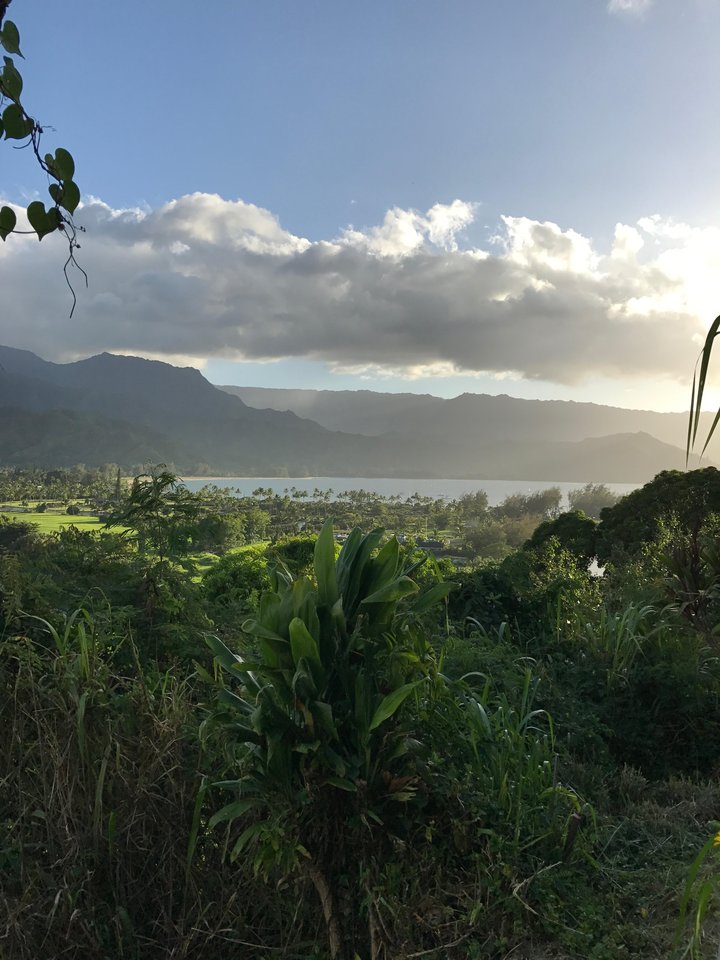
“I wouldn’t sail to Hawaii again, but I would sail somewhere else,” Nichols said while looking at her husband. “The whole not sleeping thing for 23 days is super-exhausting. It’s like having an infant that’s nursing all the time. If it was just 48 hours until we could pull in somewhere, recharge, replenish and actually get somewhere every few days to go do and see things, I could do that.”
After earning their sea legs, the couple has remained mostly humble. Attributing their successful journey to rigorous preparation and a stockpile of supplies and fancy equipment. But once in awhile, they look back on their journey and can’t help but feel accomplished.
“People are really impressed,” Nichols said. “Someone put on my Facebook page, ‘Do you ever look in the mirror and think “I’m a badass because I sailed across an ocean?”’ Sometimes I think about it and can’t believe I did it.”
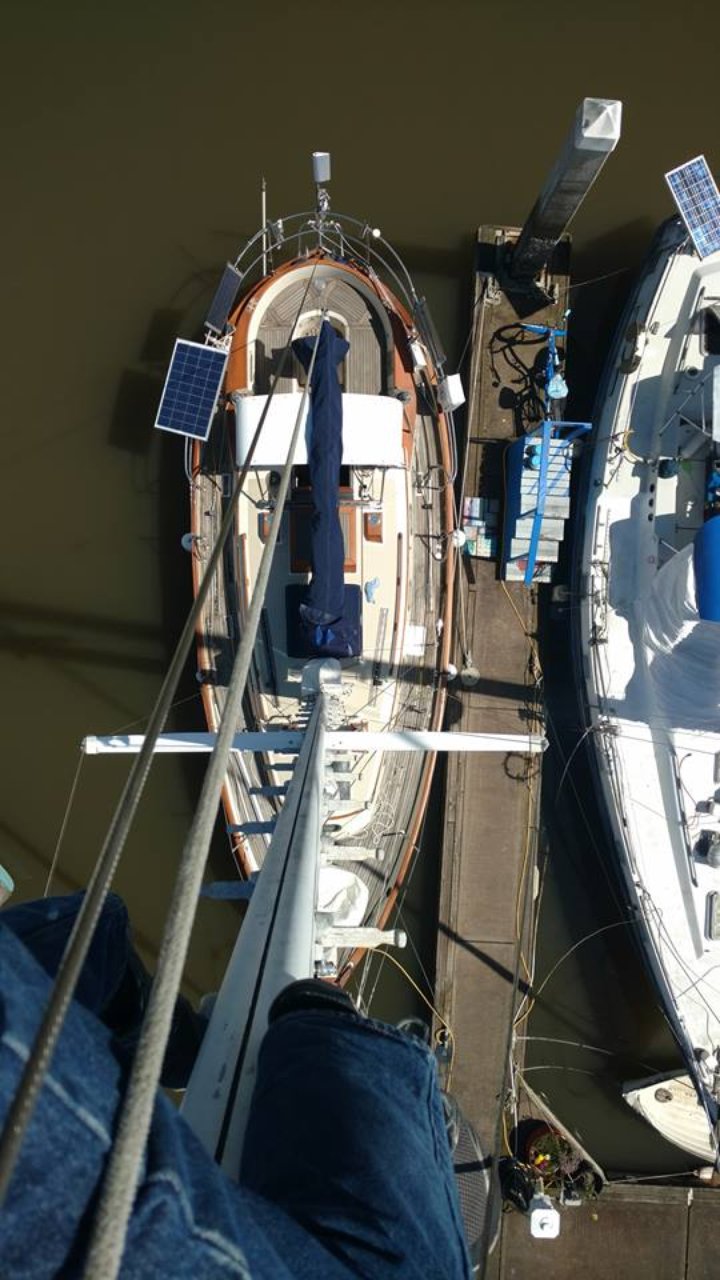
CLICK TO MANAGE